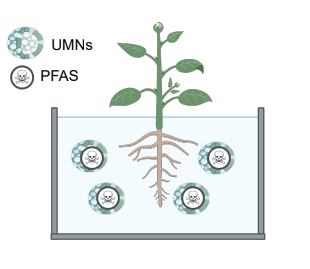Phytoremediation of PFAS with ultraporous silica nanoparticles
A method for the phytoremediation of PFAS from contaminated soil using ultraporous mesostructured silica nanoparticles.

Applications
- Environmental cleanup
- PFAS remediation
Key Benefits & Differentiators
- Effective at capturing a broad range of PFAS: By utilizing functionalized nanoparticles that have a high affinity for PFAS and are uptaken by the plants, short and long chain PFAS can be translocated from the roots to the above ground tissue.
- Captures PFAS from soil and water: These novel silica nanoparticles have an affinity for PFAS in water and potentially in soil matrices
- Sustainable: Silica nanoparticles are non-toxic, environmentally friendly, and have been shown to be beneficial to plants
- Tunable Surface: can easily be modified for desired functionality
PFAS Phytoremediation
Per- and poly-fluoroalkyl substances (PFAS) are a class of chemicals known as “Forever Chemicals” which bioaccumulate and are toxic to humans. Due to their widespread use in industry, contamination of soil and groundwater with PFAS has become common. PFAS are extremely persistent in the environment and are challenging to degrade or remediate due to their high stability and mobility. Further complicating the issue, they are present in contaminated areas as complex mixtures containing both long and short chain PFAS. Current remediation methods are limited, and are either very costly, or not applicable to remediate all types of PFAS.
Researchers at the University of Minnesota have developed a new method to remediate a broad range of PFAS from soil and water using ultraporous mesostructured silica nanoparticles (UMNs). This technology enhances the phytoremediation of PFAS by using modified ultraporous silica nanoparticles that have a demonstrated affinity for PFAS in water. These nanoparticles can be uptaken by plants, and promote the movement of both short chain and long chain PFAS from the roots to the above ground tissues which in turn facilitates PFAS removal. The ability to remediate a wide range of PFAS is critical for environmental cleanup efforts and separates this technology from traditional phytoremediation techniques which only work for the smallest PFAS molecules.
Phase of Development
TRL: 3-4Proof of concept - silica nanoparticles have been shown to uptake selected PFAS.
Desired Partnerships
This technology is now available for:- License
- Sponsored research
- Co-development
Please contact our office to share your business’ needs and learn more.
Press Releases
TEDx Minneapolis December 9, 2022Researchers
- Christy Haynes, PhD Distinguished McKnight University Professor, Department of Chemistry